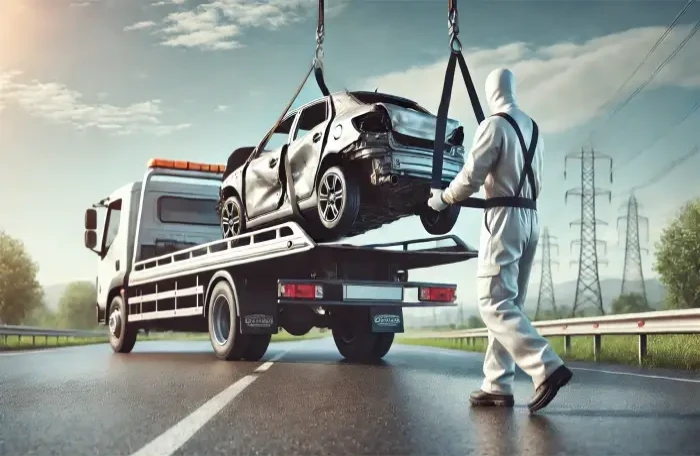Shipping Wrecked Cars Made Easy: Your Guide to Salvage Transport Services

Lila Claybourne
Oct 22, 2024

Summary:
Understanding salvage car transport
Key considerations before shipping wrecked vehicles
Benefits of professional salvage transport services
Process for transporting a wrecked car
How to choose the right salvage transport service
Insurance and legal requirements for salvage transport
FAQs about salvage car transport
Introduction: The Need for Salvage Car Transport
Wrecked cars can’t be shipped like regular vehicles. Whether your car has been totaled in an accident, bought from a salvage auction, or damaged by natural disasters like floods, it requires specialized care during transport. Shipping a wrecked car is more complex due to the vehicle's condition, which may involve non-functional parts, exposed components, or even hazardous fluids.
This is where professional salvage transport services come into play. They ensure that your damaged vehicle is moved safely, without risking further damage or legal complications. In this guide, we’ll walk you through the entire process of safely shipping wrecked cars and why using a service like AmeriFreight makes all the difference.
What Is Salvage Car Transport?
Salvage car transport refers to the shipment of vehicles that are no longer considered roadworthy due to significant damage. A salvage car, often labeled with a “salvage title,” is typically the result of accidents, natural disasters, or wear beyond repair.
These cars fall into several categories:
Totaled Vehicles: These cars have sustained so much damage that repairs would cost more than the car’s value.
Auction-Purchased Vehicles: Salvage cars bought from auctions, often for parts or restoration.
Flood-Damaged Cars: Vehicles affected by natural disasters like hurricanes, making them unsafe to drive without major repairs.
Because these vehicles can be non-operational or have severely compromised structures, transporting them requires special care, equipment, and expertise.
Key Considerations Before Shipping Wrecked Cars
Transporting a wrecked car isn’t as simple as loading it onto a standard carrier. Here are key considerations to ensure a smooth shipping process:
Vehicle Condition
Understanding and accurately conveying the condition of your vehicle is critical. If your car is non-operational, it may require special handling equipment such as winches or flatbed tow trucks to load it safely. Transporting a car with loose parts or broken glass can lead to further damage, so securing any loose items is vital.
Transport Type
For wrecked cars, you’ll typically choose between open transport and enclosed transport:
Open Transport: The more affordable option, but it leaves the vehicle exposed to the elements, which may not be suitable for severely damaged cars.
Enclosed Transport: A safer, though more expensive, method that shields the vehicle from the weather and road debris. This is ideal for high-value salvage vehicles or those with exposed components.
Loading Capabilities
Since many wrecked cars are non-operational, they cannot simply be driven onto a trailer. Professional salvage transport services use special equipment such as winches or hydraulic lifts to load non-functional vehicles safely. If the car has flat tires, they will use dollies to move it.
Pick-up and Delivery Locations
Ensure the transport company can access both the pick-up and drop-off locations. If your car is stuck in a remote or hard-to-reach area, you may need to arrange for it to be towed to a more accessible spot. Delivery locations should also be accessible for large transport trucks.
Benefits of Professional Salvage Transport Services
When it comes to transporting a wrecked or salvage vehicle, hiring a professional transport service offers several benefits that DIY transport simply cannot match:
Specialized Equipment
Salvage car transport companies have access to specialized equipment designed to handle damaged or non-operational cars. This includes flatbed trucks, winches, and hydraulic lifts. These tools ensure that your vehicle is loaded and transported without further damage.
Expertise in Handling Damaged Cars
Professional transporters understand how to handle vehicles in various states of disrepair. From securing loose parts to loading a car with broken axles, their expertise minimizes the risk of causing additional damage during transit.
Reduced Risk
Attempting to move a damaged vehicle on your own increases the risk of injury and further damage to the car. Professionals mitigate these risks by adhering to strict safety protocols and ensuring that the car is securely fastened throughout the journey.
Convenience and Safety
DIY transport often involves renting equipment, finding a trailer, and handling logistics, which can be both stressful and time-consuming. Professional services take care of everything, from loading to delivery, ensuring a hassle-free experience.
The Process for Transporting a Wrecked Car
Shipping a salvage car involves several steps, and understanding the process will help you prepare accordingly:
Step 1: Requesting a Quote
The first step in shipping your wrecked car is to request a quote from a transport service. You’ll need to provide detailed information about the vehicle, including:
Make, model, and year of the car
Current condition (e.g., non-operational, flat tires, broken windows)
Weight and dimensions of the vehicle
Pick-up and delivery locations
Providing accurate information will help the company give you the best quote for your situation.
Step 2: Preparing the Car
Before the car is picked up, it’s essential to prepare it for transport. This includes:
Securing loose parts: Any parts that may come off during transit should be secured to prevent further damage.
Removing personal items: Make sure the car is empty of any personal belongings, as they may not be covered by insurance during transport.
Step 3: Choosing the Right Transport Method
Once your vehicle is prepared, the transporter will recommend the best shipping method based on your car’s condition. Open transport may be more affordable, but enclosed transport provides better protection for heavily damaged vehicles.
Step 4: Coordinating Pick-up and Delivery
On the scheduled day, the transporter will arrive with the necessary equipment to load the car. Make sure the pick-up location is accessible, especially for larger trailers. The same applies to the delivery location – ensure it is ready for drop-off, whether it’s your home, a mechanic’s garage, or another location.
Step 5: Delivery and Inspection
Once the vehicle reaches its destination, inspect it to ensure no additional damage occurred during transport. If you notice any issues, document them immediately and report them to the transport company for follow-up.
How to Choose the Right Salvage Transport Service
Not all car transport companies are equipped to handle salvage vehicles. Here’s what to look for when choosing the right service:
Experience and Reputation
A reputable salvage car transport company should have extensive experience in handling wrecked vehicles. Look for customer reviews and testimonials that specifically mention salvage transport. Companies like AmeriFreight, with a solid reputation and years of experience, can ensure your car is in good hands.
Licensing and Insurance
Verify that the carrier selected is fully licensed and insured. This is crucial, as it protects you in case of damage during transport. Ask for proof of insurance and make sure the coverage is adequate for your vehicle’s condition and value.
Customer Service and Support
Clear communication is key when shipping a wrecked car. Choose a company that offers excellent customer service, providing you with updates on your car’s location and expected delivery time.
Cost Transparency
Some companies may offer low quotes upfront but surprise you with hidden fees later on. Ensure that the company provides a detailed, transparent breakdown of costs, including any additional charges for handling non-operational vehicles or using specialized equipment.
Insurance and Legal Considerations for Salvage Transport
Shipping a wrecked car involves more than just hiring a transport service. It’s essential to understand the insurance and legal aspects of the process.
Transport Insurance
Most transport companies offer insurance to cover damage during transit. However, this coverage may be limited, especially if the vehicle is already damaged. Be sure to check what is and isn’t covered under their insurance policy.
Salvage Title Implications
A car with a salvage title may have different transport requirements depending on state regulations. Some states have specific rules about how salvage cars can be transported, especially if the vehicle is considered hazardous.
Liability and Claims
If additional damage occurs during transport, you’ll need to file a claim with the transport company’s insurance provider. Document the condition of your car before and after transport to support any claims.
FAQs About Salvage Car Transport
What should I do to prepare my wrecked car for transport?
Secure any loose parts, remove personal items, and provide accurate information about the car’s condition to the transporter.
How do I know if my car needs an open or enclosed trailer?
Enclosed trailers offer better protection for heavily damaged or high-value vehicles, while open trailers are a more affordable option for cars that are less susceptible to weather exposure.
Is it more expensive to transport a non-operational car?
Yes, transporting a non-operational vehicle often incurs additional costs due to the special equipment and handling required.
What happens if additional damage occurs during transport?
If your car is damaged during transit, you can file a claim with the transport company’s insurance. Be sure to document the condition of your car before and after shipping.
How long does it typically take to ship a wrecked car?
Transport times vary depending on the distance, location, and condition of the vehicle. On average, expect your car to arrive within 5-10 business days for cross-country transport.
Conclusion: Trust AmeriFreight for Safe Salvage Car Transport
Transporting a wrecked car is a challenging task that requires the right equipment, expertise, and attention to detail. By choosing a professional salvage car transport service, you can ensure your vehicle is safely moved without risking further damage.
AmeriFreight offers reliable, secure, and affordable salvage car transport services, making the process stress-free from start to finish. Get a free quote today to see how we can help you move your damaged vehicle safely and efficiently.
Related Posts
















